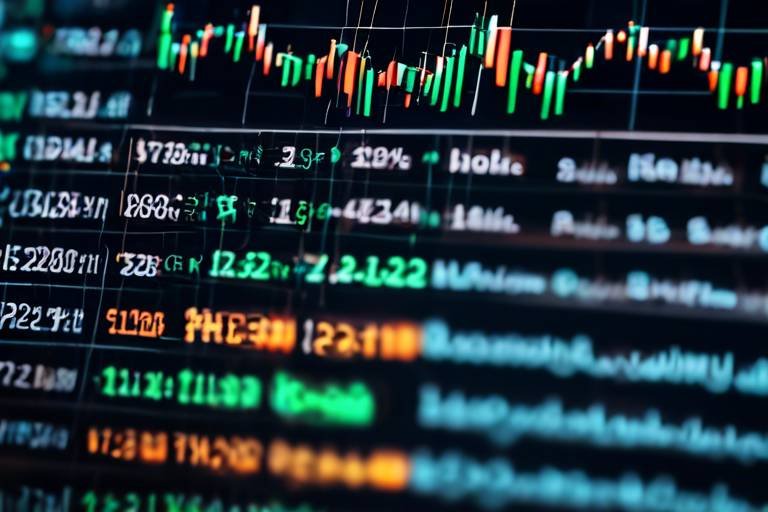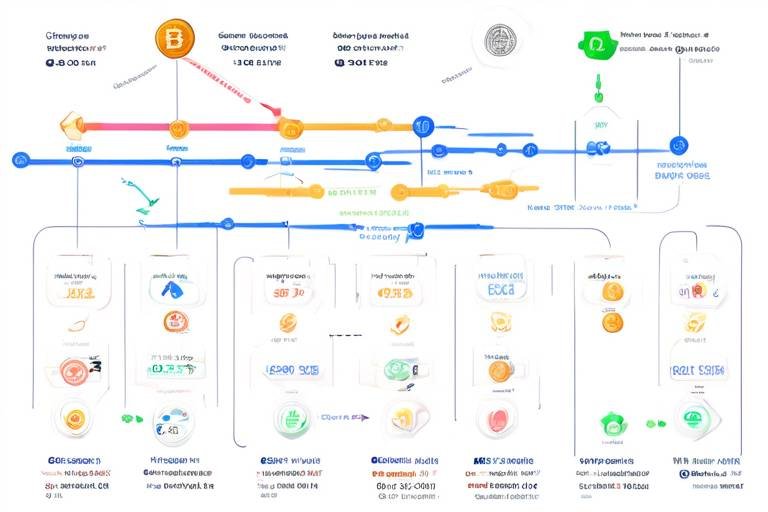The Art of Scalping - Technical Analysis for Quick Trades
Scalping is an exhilarating trading strategy that focuses on making quick profits by executing numerous trades throughout the day. Imagine being a sprinter on a track, where every second counts, and your ability to react swiftly can make or break your race. That's the essence of scalping in the financial markets! This approach is all about capitalizing on small price movements, often within minutes or even seconds, allowing traders to accumulate profits that can add up significantly over time.
But why is scalping so significant? Well, in the fast-paced world of trading, the ability to make rapid decisions based on technical analysis can provide a competitive edge. Scalpers thrive on volatility and liquidity, targeting assets that show a lot of price action. It's like fishing in a pond full of fish; the more active the water, the greater your chances of reeling in a catch. In this article, we will explore the intricacies of scalping, including key indicators and risk management strategies that can enhance your trading performance.
At its core, scalping is about taking advantage of minor price fluctuations in the market. Traders engage in this strategy by executing a large number of trades, each aiming for small gains. This method is not for the faint of heart; it requires a keen eye for detail, quick reflexes, and a solid understanding of market dynamics. Think of it as a game of chess, where every move counts, and you need to be several steps ahead of your opponent.
Scalpers often rely on technical analysis to make informed decisions. This involves using charts, patterns, and various indicators to predict price movements. The beauty of scalping lies in its simplicity and effectiveness, as traders can operate in different markets, including stocks, forex, and cryptocurrencies. With the right tools and mindset, anyone can master the art of scalping and potentially reap substantial rewards.
To be successful at scalping, traders must utilize specific technical indicators that help identify potential entry and exit points. These indicators act as a compass, guiding traders through the often turbulent waters of the market. Here are some of the most commonly used indicators:
- Moving Averages: These are essential for identifying trends and smoothing out price data.
- Volume Analysis: Understanding trading volume is crucial for confirming price movements and ensuring that trades are made with confidence.
Moving averages are a fundamental tool in the scalper's toolkit. They help traders identify the direction of the trend and serve as dynamic support and resistance levels. By smoothing out price fluctuations, moving averages provide a clearer picture of the market's behavior. There are two primary types of moving averages that scalpers often use:
The Simple Moving Average (SMA) is calculated by averaging a set number of past prices. For example, a 10-period SMA takes the average of the last 10 closing prices. This indicator is straightforward yet powerful, helping scalpers determine the overall direction of the market. When the price is above the SMA, it indicates an uptrend, while a price below the SMA suggests a downtrend. Scalpers can use this information to make quick decisions about entering or exiting trades.
On the other hand, the Exponential Moving Average (EMA) gives more weight to recent prices, making it more responsive to new information. This characteristic makes the EMA particularly advantageous for scalpers who need to react swiftly to market changes. By combining both SMA and EMA, traders can gain a comprehensive view of market trends and make informed decisions.
Volume analysis is another critical aspect of scalping. It provides insight into the strength of a price movement. A price increase accompanied by high volume suggests strong buying interest, while a price increase with low volume may indicate a lack of conviction. Scalpers can enhance their decision-making process by observing volume trends alongside price movements.
While the potential for quick profits in scalping is enticing, effective risk management is crucial to protect against significant losses. Just like a skilled tightrope walker, a scalper must maintain balance to avoid falling into the abyss of financial ruin. Here are some essential strategies to consider:
Stop-loss orders are an essential tool for limiting potential losses. By predefining a price level at which a trade will be exited, scalpers can safeguard their capital. There are several methods for setting stop-loss orders, including:
- Fixed Stop-Loss: Setting a specific dollar amount or percentage to limit losses.
- Technical Stop-Loss: Placing the stop-loss order just below a support level or above a resistance level.
Proper position sizing significantly impacts a scalper's overall success. Determining the right position size based on risk tolerance and account size is vital. A common approach is to risk only a small percentage of the trading account on any single trade, ensuring that a series of losses won't deplete the account entirely.
Q: What is scalping in trading?
A: Scalping is a trading strategy that involves making numerous trades throughout the day to capitalize on small price movements.
Q: What are the best indicators for scalping?
A: Some of the best indicators for scalping include Moving Averages (SMA and EMA) and Volume Analysis.
Q: How can I manage risk while scalping?
A: Effective risk management strategies include setting stop-loss orders and determining proper position sizes based on risk tolerance.

Understanding Scalping
Scalping is a trading strategy that has gained immense popularity among traders looking to make quick profits in the fast-paced world of financial markets. At its core, scalping involves executing numerous trades throughout the day, aiming to capitalize on small price movements. Imagine being a sprinter in a race, where every second counts, and your goal is to cross the finish line as quickly as possible. This is essentially how scalpers operate, focusing on speed and precision to seize fleeting opportunities.
The significance of scalping lies in its ability to generate profits from minimal price fluctuations. Unlike traditional trading strategies that may hold positions for days or weeks, scalpers thrive on the volatility of the market, executing trades that can last mere seconds or minutes. This approach requires not only a solid understanding of technical analysis but also a keen sense of timing and quick decision-making skills. Scalpers need to be like hawks, always on the lookout for the tiniest movements that can lead to profitable trades.
One of the key principles of scalping is the use of leverage, which allows traders to control larger positions with a smaller amount of capital. While this can amplify potential profits, it also increases the risk of significant losses. Therefore, successful scalping demands a robust risk management strategy, as traders must be prepared for rapid market changes that could quickly wipe out their gains. Think of it as walking a tightrope; one misstep can lead to a fall, but with practice and focus, one can master the art of balance.
Scalping is not just about making quick trades; it’s about understanding the market dynamics and employing technical tools to make informed decisions. Traders often rely on charts, indicators, and price patterns to identify entry and exit points. The thrill of scalping is akin to being a detective, piecing together clues to solve a mystery before time runs out. In this fast-paced environment, every second counts, and the ability to act swiftly can mean the difference between profit and loss.
In summary, scalping is a dynamic trading strategy that requires a unique blend of skills, including technical analysis, quick decision-making, and effective risk management. It’s a thrilling pursuit that can lead to significant rewards for those willing to dive into the depths of market volatility. As we delve deeper into the world of scalping, we’ll explore the key indicators that can help traders identify those golden opportunities that come and go in the blink of an eye.

Key Indicators for Scalping
When it comes to scalping, having the right tools in your trading toolbox can make all the difference. Scalping is all about speed, precision, and the ability to read market signals quickly. That’s why understanding key indicators is crucial for any scalper looking to make those quick profits. These indicators help traders identify potential entry and exit points in the blink of an eye, allowing them to capitalize on small price movements that might otherwise go unnoticed.
One of the most essential aspects of scalping is the use of technical indicators. These are mathematical calculations based on price, volume, or open interest of a security. They provide traders with insights into market trends and potential reversals. Here are some of the most commonly used indicators in scalping:
- Moving Averages
- Volume Analysis
- Bollinger Bands
- Relative Strength Index (RSI)
Each of these indicators serves a unique purpose and can be utilized in various combinations to enhance trading strategies. For instance, moving averages can help traders identify the overall direction of a market, while volume analysis provides insights into the strength of a price movement. Let’s dive deeper into some of these indicators.
Moving averages are a fundamental tool for scalpers. They smooth out price data, allowing traders to identify trends more easily. There are two main types of moving averages that scalpers often rely on: the Simple Moving Average (SMA) and the Exponential Moving Average (EMA). Both have their merits, and understanding when to use each can significantly impact your trading success.
The Simple Moving Average (SMA) is calculated by taking the average of a set of prices over a specific period. For example, a 10-period SMA adds up the last ten closing prices and divides the sum by ten. This indicator is straightforward and can help scalpers identify the overall trend. If the price is above the SMA, it might indicate a bullish trend, while prices below the SMA could suggest a bearish trend. However, the SMA tends to lag behind the price action, which can be a disadvantage in fast-moving markets.
On the other hand, the Exponential Moving Average (EMA) gives more weight to recent prices, making it more responsive to new information. This characteristic is particularly advantageous for scalpers who need to react swiftly to market changes. For instance, if you notice that the price is crossing above the EMA, it may signal a buying opportunity. Conversely, a price drop below the EMA could indicate a potential sell signal. The EMA can help traders make quicker decisions, which is essential in a scalping strategy.
Volume analysis is another critical component of scalping. It refers to the number of shares or contracts traded in a security or market during a given period. High trading volume can indicate strong interest in a particular price movement, while low volume may suggest a lack of conviction. By analyzing volume, scalpers can confirm price movements and identify potential reversals. For example, if a stock is experiencing a price increase accompanied by rising volume, it’s often seen as a bullish signal. Conversely, a price rise with low volume might indicate a lack of strength behind the move, suggesting caution.
Incorporating these indicators into your scalping strategy can provide a significant edge in the fast-paced world of trading. Remember, the key to successful scalping isn’t just about knowing these indicators; it’s about understanding how to use them in conjunction with one another to make informed decisions quickly.

Moving Averages
When it comes to scalping, are like the bread and butter of technical analysis. They are powerful tools that help traders smooth out price data to identify trends over a specific period. Think of moving averages as your trusty compass in the chaotic world of trading; they guide you through the noise, allowing you to focus on the most relevant price movements. By analyzing these averages, scalpers can make informed decisions quickly, which is crucial for their success in high-speed trading environments.
There are different types of moving averages, each serving a unique purpose. The two most commonly used are the Simple Moving Average (SMA) and the Exponential Moving Average (EMA). While both can provide valuable insights, they have distinct characteristics that can impact your trading strategy. Let’s dive deeper into these two types to see how they can aid scalpers in making quick and effective decisions.
The Simple Moving Average is the most straightforward type of moving average. It calculates the average price of an asset over a specified number of periods. For instance, a 10-period SMA takes the closing prices of the last ten candles, sums them up, and divides by ten. This gives you a smoothed line that helps you identify the overall trend.
One of the key benefits of using the SMA in scalping is its simplicity. It provides a clear visual representation of the trend, making it easier for traders to spot potential entry and exit points. However, it’s essential to note that the SMA reacts slower to price changes compared to the EMA, which means it might lag during rapid market movements. This lag can be a double-edged sword; while it can help avoid false signals, it may also cause scalpers to miss out on quick trading opportunities.
On the other hand, the Exponential Moving Average places more weight on recent prices, making it more responsive to new information. This characteristic is particularly beneficial for scalpers who need to react swiftly to market changes. For instance, if a stock suddenly spikes, the EMA will adjust quicker than the SMA, allowing traders to capitalize on momentum shifts more effectively.
When using the EMA, traders often look for crossovers between the EMA and the price or between different EMAs (like a short-term EMA crossing above a long-term EMA). These crossovers can signal potential buy or sell opportunities, making them a critical component of a scalper’s toolkit. However, it’s also crucial to combine the EMA with other indicators to confirm signals and avoid false breakouts.
| Type of Moving Average | Characteristics | Best For |
|---|---|---|
| Simple Moving Average (SMA) | Calculates the average price over a set number of periods; slower to react. | Identifying overall trends; reducing noise in volatile markets. |
| Exponential Moving Average (EMA) | Gives more weight to recent prices; reacts quickly to price changes. | Capturing quick price movements; identifying entry and exit points. |
In conclusion, whether you prefer the simplicity of the SMA or the responsiveness of the EMA, both moving averages are invaluable for scalpers. They not only help in identifying trends but also play a significant role in making quick trading decisions. By mastering these tools, you can enhance your scalping strategy and improve your chances of success in the fast-paced world of trading.

Simple Moving Average (SMA)
The is a fundamental tool in the arsenal of any scalper looking to make quick, informed trades. At its core, the SMA is calculated by taking the average of a specific set of prices over a defined period. For instance, if you're looking at a 10-day SMA, you would sum up the closing prices of the last ten days and divide that total by ten. This straightforward calculation allows traders to smooth out price data, making it easier to identify trends without the noise of daily price fluctuations.
One of the most appealing aspects of the SMA is its simplicity. It's like having a reliable compass in the often turbulent seas of trading. By observing where the price is in relation to the SMA, traders can quickly gauge whether the market is in an uptrend or downtrend. For example, if the price is consistently above the SMA, it often indicates a bullish trend, while prices below the SMA may suggest a bearish sentiment. This crucial insight can help scalpers decide whether to enter or exit a position.
However, it’s essential to understand that while the SMA is a valuable indicator, it does have its limitations. Since it is based on historical data, it can lag behind the market, which means it might not always capture rapid price movements effectively. Imagine trying to catch a fast-moving train while relying on a map that only shows the route taken yesterday—this is how the SMA can sometimes feel in a volatile market.
To make the most of the SMA, traders often use it in conjunction with other indicators. For instance, combining the SMA with the Exponential Moving Average (EMA) can provide a more comprehensive view of market trends. The EMA reacts more quickly to recent price changes compared to the SMA, allowing traders to spot potential reversals or continuations in the market more promptly. By using both indicators, scalpers can enhance their decision-making process and improve their chances of making profitable trades.
In practice, many traders will also look at different time frames when analyzing the SMA. For example, a short-term SMA (like a 5 or 10-period) might be used for quick trades, while a long-term SMA (like a 50 or 200-period) can help identify the overall trend direction. This dual approach allows scalpers to not only make quick trades based on immediate price movements but also to stay aligned with the broader market trends.
In summary, the Simple Moving Average is a powerful yet straightforward tool that can significantly aid scalpers in their trading endeavors. By providing clarity amidst the chaos of price action, the SMA helps traders make informed decisions quickly. Just remember, while it’s a fantastic tool, it’s most effective when used as part of a broader trading strategy that incorporates multiple indicators and sound risk management practices.

Exponential Moving Average (EMA)
The is a powerful tool that every scalper should have in their trading arsenal. Unlike the Simple Moving Average (SMA), which treats all data points equally, the EMA gives more weight to the most recent prices. This characteristic makes it particularly useful for scalpers who need to react quickly to market changes. Think of the EMA as a friend who always keeps you updated with the latest gossip—it's all about being in the know!
To calculate the EMA, you need to follow a specific formula that factors in the previous EMA value and the current price. The formula looks something like this:
EMA (Current Price x Multiplier) + (Previous EMA x (1 - Multiplier))
Where the Multiplier is calculated as:
Multiplier 2 / (N + 1)
Here, N represents the number of periods you want to analyze. For instance, if you're looking at a 10-period EMA, the multiplier would be 0.1818 (2/(10+1)). This means that the most recent price has a more significant impact on the EMA than older prices, allowing you to catch trends early.
One of the standout features of the EMA is its ability to react more swiftly to price changes compared to the SMA. This responsiveness is crucial for scalpers who thrive on quick trades. When the price crosses above the EMA, it often signals a buying opportunity, while a cross below may indicate a selling point. However, it's essential to remember that no indicator is foolproof. Just like a weather forecast, the EMA can provide insights, but it can’t guarantee outcomes.
Using the EMA in conjunction with other indicators can enhance your trading strategy. For example, many traders look for convergence and divergence between the EMA and price action to confirm potential trades. When the price is consistently above the EMA, it suggests a bullish trend, while a price below the EMA indicates a bearish trend. By combining the EMA with volume analysis or momentum indicators, you can gain a more comprehensive view of market dynamics.
In summary, the EMA is an essential tool for scalpers who need to make quick decisions based on the latest price movements. Its ability to prioritize recent data makes it a valuable asset in the fast-paced world of trading. However, as with any tool, it should be used in conjunction with other strategies and risk management techniques to navigate the unpredictable waters of the financial markets.
- What is the main advantage of using EMA over SMA?
The EMA reacts more quickly to price changes, making it more suitable for short-term trading strategies like scalping. - How do I choose the period for my EMA?
The choice of period depends on your trading style. Shorter periods (like 5 or 10) provide quicker signals, while longer periods (like 20 or 50) offer more stability. - Can I use EMA for long-term trading?
Yes, while EMAs are popular among scalpers, they can also be effective for longer-term trading strategies when used appropriately.

Volume Analysis
Volume analysis is a cornerstone of successful scalping strategies in the financial markets. It refers to the number of shares or contracts traded in a security or market during a given period. Understanding volume is essential for scalpers because it provides insights into the strength of price movements. Imagine trying to push a car uphill; if there’s no one to help, it’s going to be a struggle. Similarly, price movements without adequate volume can lead to false signals and unnecessary losses.
When volume increases alongside a price movement, it often indicates that the trend is strong and likely to continue. Conversely, if the price moves but the volume is low, it might suggest a lack of conviction among traders, which can lead to a reversal. This dynamic is akin to a crowd at a concert; if everyone is cheering (high volume), the band is likely on to something good, but if the crowd is sparse (low volume), the energy might not be there, signaling a potential downturn.
To effectively utilize volume analysis in scalping, traders often look at various volume indicators. Here are a few key indicators that can enhance a scalper's decision-making:
- On-Balance Volume (OBV): This indicator combines price and volume to show how much volume is flowing in and out of a security. A rising OBV suggests that buyers are willing to push prices higher.
- Volume Moving Average: By calculating the average volume over a specific period, traders can identify whether current volume is above or below the norm, helping to validate price movements.
- Accumulation/Distribution Line: This indicator helps determine whether a stock is being accumulated (bought) or distributed (sold), providing insights into potential price trends.
Incorporating volume analysis into your scalping strategy can significantly improve your ability to make quick and informed decisions. For instance, if you notice a surge in volume just before a price breakout, it could be a signal to enter a trade. However, it’s crucial to remember that volume should never be used in isolation. Always pair it with other technical indicators to confirm your analysis. Think of it like a recipe; just as you wouldn’t bake a cake with flour alone, you need a combination of ingredients to achieve the best results.
In conclusion, mastering volume analysis is about understanding the market's pulse. By paying attention to volume trends, scalpers can better navigate the fast-paced trading environment, making quick decisions that can lead to profitable trades. Just like in life, where timing and context matter, in trading, the same principles apply. So, keep your eyes on the volume, and let it guide your scalping journey!

Risk Management Strategies
When it comes to scalping, risk management is not just an afterthought; it's the backbone of a successful trading strategy. Imagine you’re a tightrope walker, balancing high above the ground. One misstep can lead to a disastrous fall. In the world of trading, that misstep can come in the form of a significant loss. Therefore, having robust risk management strategies in place is crucial to ensure you stay on that tightrope and maintain your balance.
One of the most effective ways to manage risk in scalping is through the use of stop-loss orders. A stop-loss order is a predetermined price level at which you will exit a trade to prevent further losses. Think of it as your safety net. If the market moves against you, the stop-loss order kicks in, allowing you to exit the trade before your losses escalate. There are various methods for setting these orders, including:
- Fixed Stop-Loss: This method involves setting a specific number of pips away from your entry point, which remains constant regardless of market conditions.
- ATR-Based Stop-Loss: Using the Average True Range (ATR) indicator allows you to set dynamic stop-loss levels that adapt to market volatility.
- Trailing Stop-Loss: This strategy involves moving your stop-loss order in the direction of the trade as the price moves favorably, locking in profits while still protecting against reversals.
Another essential component of risk management is position sizing. This refers to determining how much of your capital you will risk on a single trade. It’s a balancing act; risk too much, and you could wipe out your account with just a few bad trades. Risk too little, and you might miss out on potential gains. A common rule of thumb is to risk no more than 1-2% of your trading capital on any single trade. This way, even a string of losses won’t significantly dent your account balance.
To calculate your position size, you can use the following formula:
| Account Size | Risk Percentage | Risk Amount | Pip Value | Position Size |
|---|---|---|---|---|
| $10,000 | 1% | $100 | $10 | 10 lots |
| $10,000 | 2% | $200 | $10 | 20 lots |
This table illustrates how different account sizes and risk percentages affect your position size. By adhering to a well-defined position sizing strategy, you can ensure that your trading remains sustainable in the long run.
Lastly, it’s vital to maintain a disciplined approach to your trading plan. Emotions can run high in the fast-paced environment of scalping, leading to impulsive decisions that can jeopardize your capital. Stick to your predefined strategies, and don’t let fear or greed dictate your actions. Remember, even the best traders experience losses; it’s how you manage those losses that sets you apart.
Q: What is scalping in trading?
A: Scalping is a trading strategy that involves making numerous short-term trades to profit from small price movements in financial markets.
Q: Why is risk management important in scalping?
A: Risk management is crucial in scalping because it helps protect your capital from significant losses, ensuring that you can continue trading even after a series of losing trades.
Q: How do I set a stop-loss order?
A: You can set a stop-loss order by determining a price level at which you want to exit the trade if it goes against you. This can be done using fixed levels, ATR-based levels, or trailing stops.
Q: What is the ideal position size for scalping?
A: The ideal position size depends on your account size and risk tolerance. A common guideline is to risk no more than 1-2% of your trading capital on a single trade.

Setting Stop-Loss Orders
In the fast-paced world of scalping, where every second counts, setting stop-loss orders becomes a crucial part of your trading strategy. Imagine you're a race car driver; you wouldn't want to drive without a seatbelt, right? Similarly, stop-loss orders act as your safety harness, protecting you from potentially devastating losses. These orders automatically close your position when the price reaches a certain level, ensuring that you don't lose more than you're willing to risk.
There are various methods for setting stop-loss orders, and understanding them can significantly enhance your trading experience. One common approach is to set a stop-loss at a fixed percentage below your entry price. For example, if you buy a stock at $100, you might decide to set a stop-loss at $95, which represents a 5% risk. This method is straightforward and allows you to define your risk level upfront. However, it's essential to consider market volatility; a stop-loss set too close to the entry point might trigger unnecessarily due to normal price fluctuations.
Another effective strategy is to use technical analysis to determine the placement of your stop-loss orders. This could involve placing your stop-loss just below a significant support level or moving average. For instance, if you're trading on a 5-minute chart and notice that the price tends to bounce off a certain level, you might set your stop-loss slightly below that level. This approach not only provides a buffer against minor price swings but also increases the likelihood that your trade will remain open longer, allowing you to capture those quick profits.
Here's a quick overview of the different methods for setting stop-loss orders:
- Fixed Percentage: Set a stop-loss at a specific percentage below the entry price.
- Support/Resistance Levels: Place the stop-loss just below support or above resistance levels.
- Volatility-Based: Use indicators like the Average True Range (ATR) to determine optimal stop-loss distance based on market volatility.
It's also important to regularly review and adjust your stop-loss orders as the trade progresses. As a scalper, you might consider employing a trailing stop-loss, which moves up with the price as it rises. This way, you can lock in profits while still giving your trade room to breathe. Think of it as a safety net that tightens as you gain altitude, ensuring that you come down safely should the market turn against you.
In conclusion, setting stop-loss orders is not just about protecting your capital; it's a critical component of a disciplined trading strategy. By carefully considering your risk tolerance and employing various methods for placement, you can safeguard your trades and enhance your overall performance in the exhilarating world of scalping.
Here are some common questions traders have about setting stop-loss orders:
- What is the best stop-loss percentage for scalping? It varies by trader, but many scalpers use a range between 1% to 3% of their entry price.
- Can I adjust my stop-loss after entering a trade? Absolutely! You should regularly review and adjust your stop-loss based on market conditions and price movements.
- What happens if my stop-loss is triggered? When your stop-loss is triggered, your broker will execute a market order to close your position at the best available price.

Position Sizing
When it comes to scalping, is one of the most critical elements that can make or break your trading success. Imagine you’re at a carnival, trying to win that giant teddy bear. You wouldn’t throw all your tokens at once, right? Instead, you’d want to spread your bets wisely to maximize your chances of winning without losing everything in one go. The same principle applies to trading, especially in the fast-paced world of scalping.
Position sizing is essentially about determining how much of your trading capital you should allocate to a single trade. This decision is influenced by various factors, including your overall risk tolerance, the volatility of the asset you’re trading, and your trading strategy. If you’re too aggressive and risk too much on a single trade, you could wipe out your account in no time. On the other hand, being overly cautious might prevent you from reaping the rewards of your trades.
To effectively determine your position size, consider the following steps:
- Assess Your Risk Tolerance: How much are you willing to lose on a single trade? A common rule of thumb is to risk no more than 1-2% of your total trading capital on any given trade.
- Calculate Your Stop-Loss: Before entering a trade, decide where you will place your stop-loss order. This is crucial because it helps you define your potential loss upfront.
- Use a Position Sizing Formula: One popular formula is: Position Size (Account Balance x Risk Percentage) / Trade Risk. This formula helps you calculate the number of shares or contracts to buy based on your risk tolerance and the distance to your stop-loss.
For example, let’s say you have a trading account of $10,000 and you’re willing to risk 1% on a trade. That means you’re comfortable risking $100. If you determine that your stop-loss is set to allow for a $2 loss per share, you would calculate your position size as follows:
| Account Balance | Risk Percentage | Trade Risk (Stop-Loss) | Position Size |
|---|---|---|---|
| $10,000 | 1% | $2 | 50 shares |
This means you would buy 50 shares of the asset, ensuring that if the trade goes against you, your loss will remain within your risk tolerance. It’s all about striking that delicate balance between taking advantage of market opportunities and protecting your capital.
Another important aspect of position sizing is to adjust it according to the market conditions. If you’re trading a highly volatile asset, you might want to reduce your position size to mitigate risk. Conversely, if the market is stable, you can afford to increase your position size slightly. Always remember that flexibility is key in trading.
In summary, mastering position sizing is crucial for any scalper aiming for long-term success. It’s not just about how much you trade, but how wisely you manage your capital. By applying the principles of position sizing diligently, you can navigate the thrilling world of scalping with greater confidence and control.
1. What is the best position size for scalping?
The best position size varies depending on your risk tolerance, account size, and the volatility of the market. A good rule of thumb is to risk no more than 1-2% of your total capital on any single trade.
2. How do I determine my stop-loss level?
Your stop-loss should be based on technical analysis, such as support and resistance levels or volatility measures. It’s essential to set it at a level that allows for normal market fluctuations while protecting your capital.
3. Can I adjust my position size during a trading session?
Absolutely! It’s wise to adjust your position size based on market conditions. If the market becomes more volatile, consider reducing your position size to manage risk effectively.
Frequently Asked Questions
- What is scalping in trading?
Scalping is a trading strategy that involves making multiple trades throughout the day to profit from small price movements. It’s all about quick decisions and rapid trades, aiming to capitalize on minor fluctuations in market prices.
- What are the key indicators used in scalping?
Scalpers often rely on technical indicators like Moving Averages, Volume Analysis, and various oscillators. These tools help traders identify potential entry and exit points swiftly, allowing them to make informed decisions in a fast-paced environment.
- How do Moving Averages assist scalpers?
Moving Averages, especially the Simple Moving Average (SMA) and Exponential Moving Average (EMA), help smooth out price data to identify trends. The SMA offers a basic view of price movements, while the EMA gives more weight to recent prices, making it particularly useful for quick trades.
- What is the importance of volume analysis in scalping?
Volume analysis is crucial for confirming price movements. By understanding trading volume, scalpers can gauge the strength of a price trend, which aids in making better trading decisions. High volume often indicates strong momentum, making it a key factor in successful scalping.
- How can I manage risks while scalping?
Effective risk management is vital in scalping. Traders can set stop-loss orders to limit potential losses and determine proper position sizing based on their risk tolerance and account size. This ensures that even in fast-moving markets, they can protect their capital.
- What are stop-loss orders and how do they work?
Stop-loss orders are predetermined price levels set by traders to automatically sell a security when it reaches a certain price, limiting potential losses. For scalpers, these orders are essential to manage risk and maintain discipline in volatile markets.
- How do I determine the right position size for scalping?
Determining the right position size involves assessing your risk tolerance and account size. A common method is to risk a small percentage of your total capital on each trade, which helps to manage losses and maintain the longevity of your trading strategy.
- Is scalping suitable for all traders?
Scalping may not be suitable for everyone. It requires quick decision-making, a solid understanding of technical analysis, and the ability to handle stress in fast-paced environments. If you prefer a slower, more methodical approach to trading, scalping might not be the best fit.



















